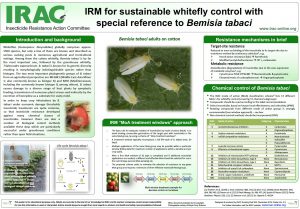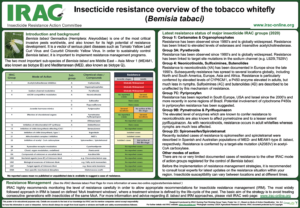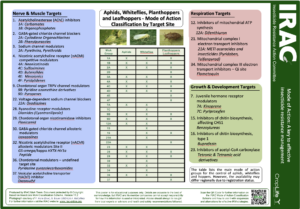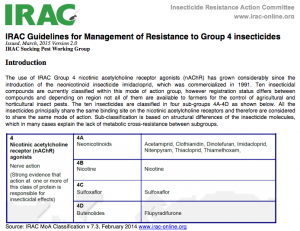Tobacco Whitefly
Bemisia tabaciBemisia tabaci Gennadius (Hemiptera: Aleyrodidae) is one of the world’s top 100 invasive organisms found on over 900 host plants all around the world. It is currently recognized as a complex of cryptic species with world wide distribution. The two most important phylogenetic groups of B. tabaci from an agricultural perspective are MEAM1 (Middle East-Asia Minor 1; also commonly known as biotype B) and MED (Mediterranean; including the commonly known biotype Q among others). It reportedly transmits over a hundred virus species some of which are of high economic importance. The whitefly thrives in tropical, subtropical, and less predominately in temperate habitats. It is also a major pest of glasshouses.
Infestation is easily recognized by examining the undersides of leaves, where all stages of the insect can usually be found. The infested leaves will start to show a yellow mosaic, with the green areas becoming ever smaller. Twisting of stems and curling of leaves may occur, and the plants may become stunted. Heavily-infested leaves often wilt and fall off. In addition to direct feeding, all stages damage the plants through abundant production of honeydew, which encourages the growth of sooty molds, and, most importantly, by the transmission of viruses.
Tobacco Whitefly resistance profile
B. tabaci has tremendous potential to develop resistance to insecticides. The two most damaging biotypes of B. tabaci are the MEAM1 and MED biotypes. The MEAM1 -type has a worldwide distribution. The MED-type was largely restricted to the Mediterranean area but has recently moved to the U.S.A and China. To date, B. tabaci has shown resistance to more than 50 active ingredients of insecticides and several multi-resistant B. tabaci populations, particularly of the MED biotype, have also evolved in the field. The table below shows the major resistance mechanisms and the impacted chemical classes.
| Species | Distribution | Chemical class | Mechanisms |
|---|---|---|---|
| Bemisia tabaci | Worldwide | Carbamates (1A) | Metabolic-Elevated level of Carboxylesterases |
| Bemisia tabaci | Worldwide | Organophosphates (1B) | Metabolic-Elevated level of Carboxylesterases |
| Bemisia tabaci | Worldwide | Pyrethroids-Pyrethrins (3A) | Metabolic-Elevated level of Carboxylesterases |
| Bemisia tabaci | Worldwide | Neonicotinoids (4A) | Metabolic-Elevated level of Monoxigenase P450 |
| Bemisia tabaci | Worldwide | Pymetrozine (9B) | Metabolic-Elevated level of Monoxigenase P450 |
| Bemisia tabaci | Worldwide | Pyriproxyfen (7C) | Metabolic- Elevated level of Monoxigenase P450 |
| Bemisia tabaci | Worldwide | Carbamates (1A) | Target site - MACE (Acetilcolinesterase modification) |
| Bemisia tabaci | Worldwide | Pyrethroids-Pyrethrins (3A) | Target site- L925I, M918V, T929V |
| Bemisia tabaci | Non specified | Cyclodiene organochlorines (2A) | Target site – A302S/N |
| Bemisia tabaci | Non specified | Phenylpyrazoles (Fiproles) (2B) | Target site – A302S/N |





